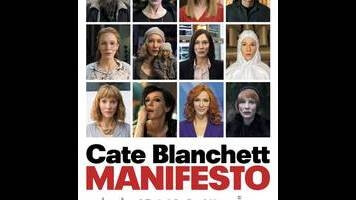Blanchett is as virtuosic as you might expect. The chameleonic quality she exhibited in I’m Not There (and in Coffee And Cigarettes, where she played cousins) is on full display here as she seamlessly slips between accents, genders, and personas. She’s also funny—riotously so at some points. In another universe you could dress her up in all these kooky costumes, and she’d be an invaluable Saturday Night Live cast member. The humor isn’t accidental. Manifesto, as high-minded as it is, doesn’t take itself all that seriously. Take, for instance, the pop-art entry, where Blanchett plays a buttoned-up housewife leading her family in a prayer that’s actually Claes Oldenburg’s irreverent manifesto “I Am For An Art.” Or you could go with her bizarro newscaster asking questions of a roving reporter (also Blanchett) about conceptual art in a voice that may bring to mind Parks And Recreation’s Perd Hapley. These discordant juxtapositions are designed to provoke giggles. But not every segment trades in this kind of clash. The puppeteer crafting a tiny Cate Blanchett while discussing surrealism, is, well, surreal. It’s a perfect match of subject matter to image.
Each of Blanchett’s characters exists in a complete environment, and Rosefeldt’s camera is keen to reveal the gags and treasures contained within each. In one case, there’s a pan to a random room full of taxidermied animals. In another, Blanchett ends up in a lavish, mysterious laboratory. These are not just sets, but whole universes, and Rosefeldt introduces them with long, loving takes. The director is fixated on patterns and finds them within the seemingly endless spaces. If you listen closely, you’ll hear repetition in the manifestos as well. (Rejection is a theme that keeps popping up.) Similarities are especially highlighted in the final moment, when all the Blanchetts read their treatises in harmony. One gets the sense that some of the monotony is purposeful, but that can also make it easy to drift from the words—especially when the visual language of the film is so fascinating.
Manifesto was previously staged as an art installation, and in many ways it feels like its true home is the gallery rather than the movie theater. When it was exhibited in the cavernous Park Avenue Armory in New York, each Blanchett inhabited a different, oversize screen, all playing simultaneously and syncing up at an appropriate moment. It was a choose-your-own-adventure for viewers, who could design the order in which they watched the pieces, which in turn read as individual shorts. For the movie version, Rosefeldt necessarily has to regiment how we experience the work, but that arguably lessens its overall effect. Some of the sections are arbitrarily broken up, while others remain intact. Manifesto works best as a thought experiment; fitting it into cinematic convention makes it a little more boring and confounding.
In the final minutes, Blanchett, playing a homeless man, spits a line from a situationist text that reads as a challenge to the audience—essentially a fuck-you if you don’t understand what you just witnessed. Rosefeldt and Blanchett want to get you thinking about their intentions, about how all these separate pieces add up. But the joy of their project lies in its cheekiness, in the more irreverent way they approach topics usually relegated to the realm of college seminars.


 Keep scrolling for more great stories from The A.V. Club.
Keep scrolling for more great stories from The A.V. Club.